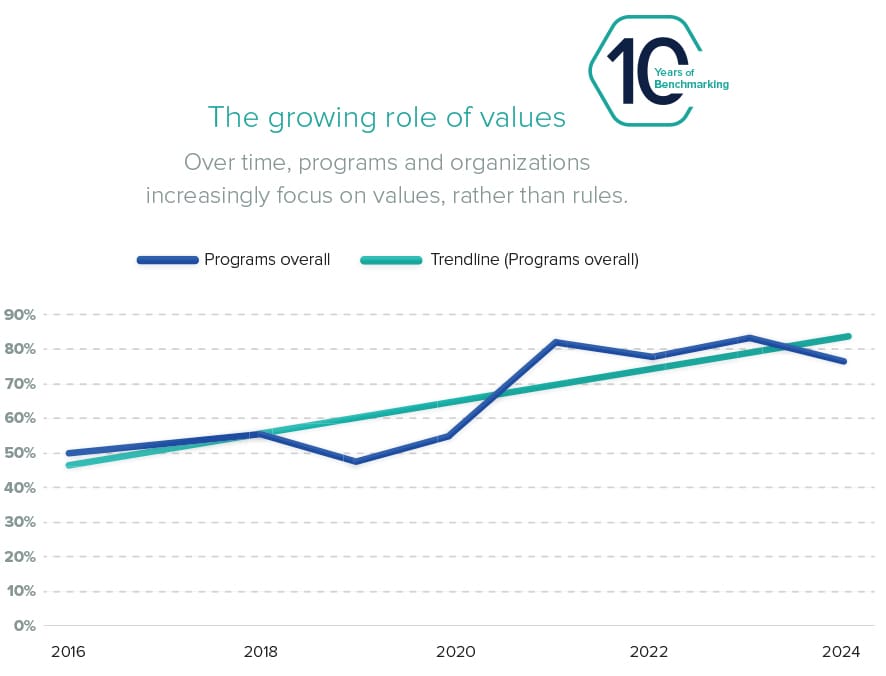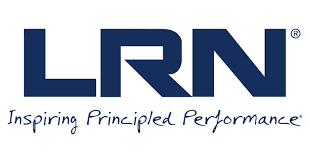(Sponsored)
As geopolitical events, new technology and regulatory developments increase the severity and frequency of risks, E&C programs are focused on their risk mitigation efforts. As LRN’s Susan Divers explores, a central lesson from over 10 years of primary research is that values-based programs are not only the most effective but also correlate strongly with reduced risk and better business outcomes.
This is validated in our brand-new 2024 Ethics and Compliance Effectiveness Report, which features global data and insights from more than 1,400 E&C professionals. This report also marks 10 years of LRN benchmarking crucial data on program evolution for E&C professionals worldwide.
But how exactly are E&C programs evolving in response to this increasingly complex risk landscape? And what do global best practices look like going into 2024? Let’s dig into five key insights from the report (download it here) and what they mean for improving ethics and compliance program effectiveness in 2024.
Taking a values-based approach to compliance is the path forward
Values as the principal means of motivating ethical behavior has become a fundamental principle of E&C programs, and is a best practice that has gained traction over time. According to the report, 77% of E&C professionals indicated their organization emphasizes values rather than rules to motivate ethical behavior — a 27 percentage-point increase from when LRN first asked this type of question in 2016.
Risk mitigation and analysis are top E&C priorities for 2024
Program effectiveness is foundational to risk mitigation. Global ethics and compliance programs ranked risk mitigation and risk analysis as their top priorities for improvement and usefulness for evaluating program impact.
 Operationalizing ethics and compliance presents challenges
Operationalizing ethics and compliance presents challenges
The gap between leadership and middle management when it comes to operationalizing E&C continues to grow. There is a 37 percentage-point difference between leaders and managers who lean on company values to make tough decisions — the highest gap since LRN started collecting data on this point.

Employee-focused training is a hallmark of highly effective E&C programs
While 74% of global E&C professionals reported making significant changes to their programs to meet the needs of employees working remotely and on a hybrid basis, companies with high-performing E&C programs were nearly twice as likely to make these changes for their employees.

Our report found that high-performing E&C programs are also 1.9 times more likely to have their training systems improved to be more user-friendly and increase overall effectiveness. In addition, they are 1.7 times more likely to both use a dedicated E&C training library for their program and use their training providers’ platform to distribute E&C training.
The need for good data and analytics is crucial for effective risk mitigation
Ongoing evaluation, particularly in light of changing risks, is a key component of program effectiveness. The 2024 report found that high-performing E&C programs are 2.1 times more likely to leverage data from a variety of sources to guide program focus and development — using risk analysis, misconduct trends and patterns, root cause analysis data, ethical culture surveys, training content retention, benchmarking and much more. Notably, high-performing programs are nearly three times as likely to benchmark against other E&C programs. This can provide global and industry-specific context on program design, one of the three fundamental criteria in the DOJ’s “Evaluation of Corporate Compliance Programs” guidance.

The key takeaway
The 2024 Ethics & Compliance Program Effectiveness Report validates a central lesson from over 10 years of primary research — values-based E&C programs are not only the most effective but also correlate strongly with reduced risk and better business outcomes. to get the latest metrics and uncover best practices you can adopt right now to reduce risk and strengthen the foundations of your E&C program.





 Susan Divers is a senior adviser with LRN. In that capacity, she brings her 30-plus years of accomplishments and experience in the ethics and compliance area to LRN partners and colleagues. This expertise includes building state-of-the-art compliance programs infused with values, designing user-friendly means of engaging and informing employees, fostering an embedded culture of compliance, and substantial subject matter expertise in anti-corruption, export controls, sanctions and other key areas of compliance. Prior to joining LRN, she served as AECOM’s assistant general for global ethics and compliance and chief ethics and compliance officer. Under her leadership, AECOM’s ethics and compliance program garnered six external awards in recognition of its effectiveness and Divers’ thought leadership in the ethics field.
Susan Divers is a senior adviser with LRN. In that capacity, she brings her 30-plus years of accomplishments and experience in the ethics and compliance area to LRN partners and colleagues. This expertise includes building state-of-the-art compliance programs infused with values, designing user-friendly means of engaging and informing employees, fostering an embedded culture of compliance, and substantial subject matter expertise in anti-corruption, export controls, sanctions and other key areas of compliance. Prior to joining LRN, she served as AECOM’s assistant general for global ethics and compliance and chief ethics and compliance officer. Under her leadership, AECOM’s ethics and compliance program garnered six external awards in recognition of its effectiveness and Divers’ thought leadership in the ethics field.







